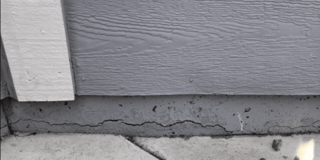Prime
Why foundations crack during construction

Non-structural cracks do not affect the integrity of the structure. Watch out for the structural cracks. PHOTO/net.
What you need to know:
Foundations crack due to different causes. While some cracks are expected others are dangerous and need to be fixed before the problem spreads to other parts of the structure.
A foundation that cracks during construction is never a good sign. However, experts say not all cracks should be a cause for worry.
Patrick Kalamuzi, a civil engineer says sometimes the foundation cracks because of shrinkage during the concrete curing process. These non-structural shrinkage cracks do not affect the integrity of the structure, it is the structural cracks that one should watch out for. Here are some of the causes and how to fix them.
Poor levelling
Kalamuzi says one of the major reasons for cracks appearing in the foundation is poorly compacted soil before construction begins. When this happens and a heavy structure is built on top, it will sink into the ground unevenly, causing foundation damage.
Poor levelling also affects the structure, that is why after a short period of time the house starts sinking and getting cracks in the walls. To avoid this type of damage, Kalamuzi stresses that a qualified engineer must be consulted to take measurements and ensure they are followed by the builders.
“Foundation depth is dependant on ground conditions, soil type and proximity of trees etc. If the new building is being built on a demolition site or has unstable ground conditions, then piled foundations may be required.However, if you are building a bungalow measurements need to be 600mm wide x 1m deep minimum. In some cases, depending on ground type, proximity of large trees footings are required to be up to 2m deep,” he says.
Quality of materials
The quality of materials used will also affect the foundation. Kalamuzi says the materials should be at least as durable as the rest of the structure. Foundations are subject to attack by moisture, rodents, and termites and, to a limited extent, wind.
The moisture may come from rain, surface water or groundwater and, although a footing drain can reduce the problem, it is important to use a foundation material that will not be damaged by water or the lateral force created by saturated soil on the outside of the wall.
The foundation must also be watertight in order to prevent water from penetrating into a basement or up through the foundation and into the building walls above.
Concrete is one of the best foundation materials because it is hard, durable and strong in compression. It is not damaged by moisture and can be made nearly watertight for basement walls. It is easy to cast into the unique shapes required for each foundation.
However, the main disadvantage is the relatively high cost of the cement required to make the concrete. Other materials that can be used for a strong foundation include stones, earth, poured concrete and concrete blocks.
Type of the soil
Not all soil is the same, different types react differently to moisture and their effects on the foundation vary. Sometimes, a structure is set on limestone, sandstone, or bedrock; each of which is capable of handling heavy loads. Soil that does not drain well and was not compacted correctly before the foundation was poured will eventually damage your foundation.
Expanding soil can lead to foundation shifting, cracks in the concrete, water stains, uneven walls and mould. It all comes down to moisture since too much moisture negatively affects a structure. Kalamuzi says loam soil is the best type on which to pour a foundation because it contains sand and silt with some clay in the mixture. It absorbs moisture and dries out at an even rate. Air circulates well through loam and drains nicely.
Kalamuzi stresses that it is normal for soil shifts to occur when a home is first constructed.
“You should worry when you start seeing more than one or two short, hairline cracks in the concrete, if there are several wide cracks. In other areas of the home, look for cracked windowpanes, sagging floors, cracks in the ceiling, windows that do not open or close properly and doors that stick or have gaps along the doorjambs. If you find any of these, the solution is concrete injection. This is a method that is used to fill cracks in the foundation with a cement-like material. It is a relatively simple process and can be done quickly and easily,” he says.
Trees
Kalamuzi says big trees around your structure can also cause foundation cracks when their roots penetrate through the soil and hit the foundation from the ground. The most common trees that damage building foundations include Norway maples, silver maples, oaks, ash, poplar, walnut, cottonwood, and sycamore trees. These trees have a high potential to do damage underground.
“Make sure that while constructing the foundation you cut down nearby trees and uproot them to avoid stubborn roots that may affect the structure.If you find no roots in the direct line from the tree, excavate a few feet in each direction to ensure you are seeing the whole scope of the root system, ” he advises.
Repair methods
There are many different foundation repair methods available, but not all of them are equally effective. The best foundation repair method depends on the specific situation and the condition of the foundation. If you are experiencing problems with your foundation, it is important to consult with a professional foundation repair specialist to find the best solution for your needs.




